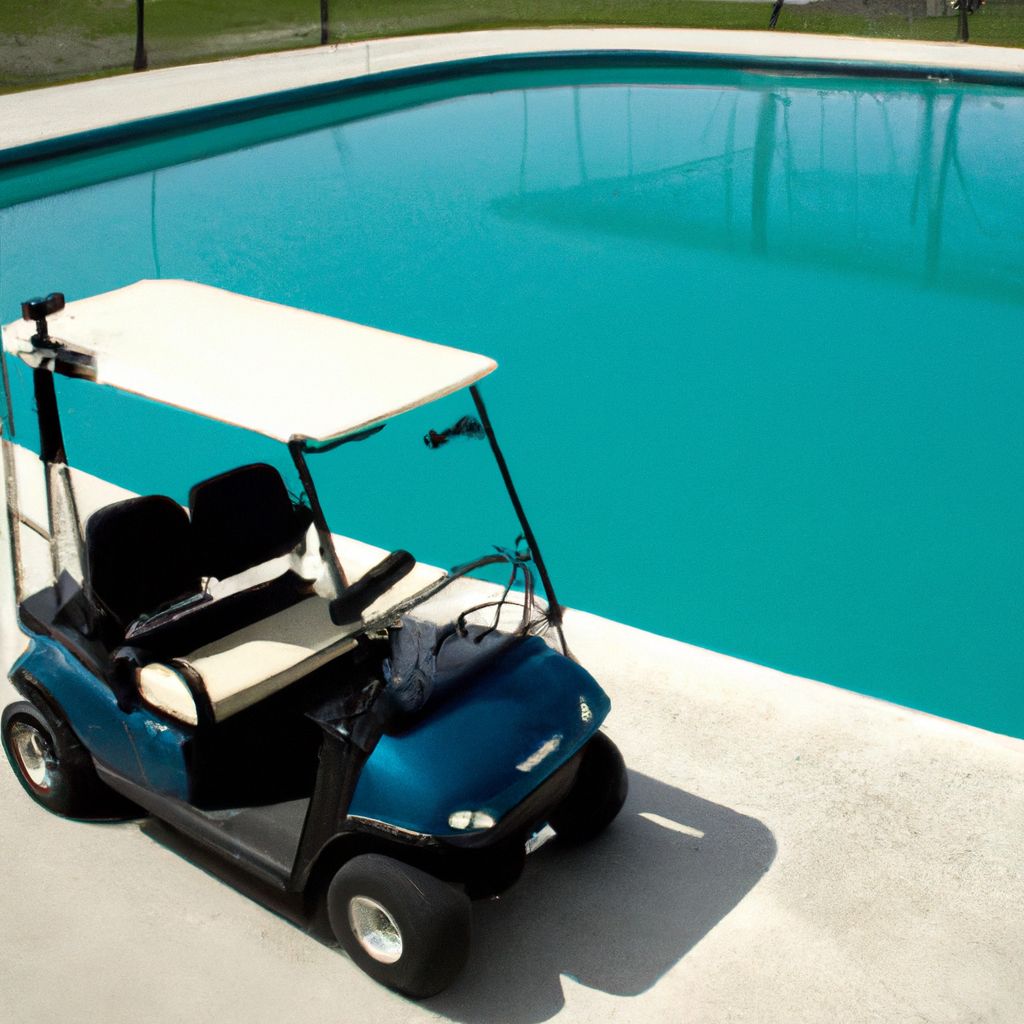How to drive a golf cart
Key Takeaways:
- Understanding the basics of driving a golf cart is essential, including starting the cart, knowing the different types of carts, and taking necessary safety precautions.
- Navigating the golf course safely involves following rules and regulations, staying on designated paths, and being respectful of other golfers and pedestrians on the course.
- To master control and maneuverability of a golf cart, familiarize yourself with its controls and features, handle acceleration and braking smoothly, and practice proper turning and steering techniques.
- Additional considerations for golf cart driving include using lights and signals when driving at night, understanding specific golf cart etiquette, and obtaining insurance for protection.
- Commonly asked questions about driving a golf cart include whether it is hard to drive, if you can drive in reverse, and what rules and regulations apply to golf cart usage.
Understanding the Basics of Driving a Golf Cart
Understanding the basics of driving a golf cart is crucial for a smooth and safe ride. From starting the cart to taking the necessary precautions, this section will provide you with valuable insights. Learn about the different types of golf carts and the importance of putting on your seatbelt. Get ready to navigate the course with confidence and maximize your golfing experience.

Starting the Golf Cart
Getting your golf cart ready to go is a process. To start it safely, here’s what you need to do:
- Flip the ignition switch. This will make the cart’s electrical system active.
- Check the battery. Make sure it’s charged with the battery gauge or indicator light.
- Step on the accelerator pedal. Press down on it slowly to control your speed. Gasoline and electric carts have different acceleration.
- Release the parking brake. Foot lever, button or pedal – depends on the model.
- Check your surroundings. Make sure there are no obstacles and all passengers are seated.
This guide is only a basic overview. Refer to your cart’s owner’s manual for detailed instructions. Doing these steps will make starting your cart smooth and your experience enjoyable!
Different Types of Golf Carts
Golf carts come in different types to suit different needs and wants. Each type has its own features and advantages that make the driving experience more fun. Knowing these variations is key to choosing the ideal cart for you.

Let’s go through the types of golf carts:
| Type of Golf Cart | Description |
|---|---|
| Gas-Powered | Powered by gasoline engines, they are powerful and drive faster. Good for covering long distances without needing to recharge often. |
| Electric | Electric motors powered by batteries. Less noisy, eco-friendly, and require minimal maintenance. |
| Solar-Powered | Charge their batteries using solar panels. Depend less on external energy sources and are eco-friendly. |
| Off-Road | Suited for rugged terrain. Have stronger suspensions, larger wheels, and higher ground clearance for smooth navigation on trails and rough surfaces. |
Some golf courses may restrict certain types of golf carts due to safety or environmental reasons.
Consider your needs when selecting the right cart. There’s a range of options to meet everyone’s preferences while ensuring a great golf cart driving experience – from gas-powered carts for long drives to electric carts for a quieter ride.
It’s like a roller coaster, but slower – hop into your golf cart and buckle up!
Putting on Your Seatbelt and Taking Precautions
- Secure your seatbelt tightly before entering the golf cart.
- Before starting the cart, inspect it for any visible damages or malfunctions.
- Ensure all passengers wear their seatbelts too.
In addition, check if the golf course has any specific regulations regarding seatbelts. Know emergency procedures in case of an unexpected situation. Being informed and prepared can guarantee a safe and enjoyable golf cart driving experience.
The emphasis on putting on seatbelts and taking precautions has risen due to accidents and incidents involving golf carts. Golf courses have implemented strict rules for wearing seatbelts while driving golf carts. This has reduced injuries caused by ejections and falls from moving carts. It is essential for every golfer using a golf cart to prioritize their safety by following seatbelt usage guidelines provided by the course management.
So, go ahead and buckle up for a safe golfing experience!
Navigating the Golf Course Safely
When navigating the golf course safely, it is crucial to follow course rules and regulations, stay on the designated cart path, and be mindful of other golfers and pedestrians. By adhering to these guidelines, not only do you ensure your own safety, but you also contribute to the overall enjoyment of the game for everyone involved. So, let’s explore how we can navigate the golf course with caution and consideration in these key areas.

Following Course Rules and Regulations
Following the rules of the golf course is key for a safe and fun experience. It is important to respect boundaries, pay attention to signage, adhere to speed limits, let other golfers go first, and be quiet. Some golf courses may have extra rules, so check before you play. Don’t miss out on a great round by not following the rules. Be a responsible golfer and follow these guidelines for the best experience.
Staying on the Designated Cart Path
Staying on the designated cart path is essential. Golf courses have paths meant only for golf carts. It’s important to stay on these paths to protect the course and other players.
Adhere to all course rules and follow any signage. These paths are designed to keep the playing surface in good condition. By staying on the path, you can help maintain it.
Be mindful of other golfers and pedestrians. Be aware and yield right of way when necessary. Staying on the path helps avoid collisions.
To summarize: It’s important to stay on the cart path. Follow course rules, be mindful of others, and enjoy a safe experience.
Being Mindful of Other Golfers and Pedestrians
Awareness of other golfers and pedestrians is crucial for a safe golf cart driving experience. Keeping alert helps to prevent accidents and ensure everyone’s safety.
Rules and regulations must be followed to keep order and reduce potential hazards. Obey speed limits. Don’t drive recklessly. Respect designated areas for cart usage.
Stay on the cart path as much as possible. It will reduce interference with other golfers and help keep everyone safe. Always look out for others. They may not be paying attention or aware of your presence. Slow down or stop when approaching busy areas. Give people enough room and time to move out of your way.
Communicate with other users by using signals or gestures. This prevents confusion or collisions. Being considerate promotes a positive atmosphere.
Some golf courses may have specific guidelines in place for sharing paths or yielding right-of-way. Make sure to read up before driving.
A golfer reported almost crashing into a pedestrian who darted across from behind a tree without looking. This highlights the importance of being mindful and aware of other golfers and pedestrians.
Control and maneuverability are key. Crashing a golf cart can really ruin your game… and pride.
Mastering Control and Maneuverability
Mastering control and maneuverability is crucial when it comes to driving a golf cart. In this section, we will discuss essential techniques to help you navigate your golf cart with confidence. From familiarizing yourself with the controls and features to handling acceleration and braking, as well as mastering turns and steering techniques, we will provide you with the necessary insights to enhance your control over the golf cart and ensure a smooth and enjoyable drive.
Familiarizing Yourself with the Controls and Features
- Familiarize yourself with the golf cart controls and features. Here’s how:
- Get to know the dashboard. Inspect the gauges, indicators, and switches. Learn their functions and how they affect the cart.
- Understand the steering mechanism. Grip and steer properly. Different carts may have variations, so know yours. Practice left and right turns.
- Locate the accelerator and brake pedals. Understand how much pressure to apply. Gradually practice on both pedals.
- Try out any additional features or accessories. Headlights, turn signals, horn, windshield wipers, etc. Familiarize yourself with them.
- Note that different types of golf carts may vary. Refer to your model’s manual for specific instructions.
Handling Acceleration and Braking
Acceleration and braking are important for a smooth and controlled golf cart ride. To drive safely, one needs to know how to handle these properly.
- Learn the Controls: Become familiar with the position of the acceleration and brake pedals. Understand how each responds when pressed.
- Acceleration: When accelerating, press the pedal gently. Sudden pressure can cause jerky movements and sudden bursts of speed. Slow and steady acceleration helps maintain control.
- Braking: To brake effectively, press the pedal slowly. Avoid slamming on the brakes, as this can cause skidding and discomfort.
These steps will help you handle acceleration and braking with confidence. It is also important to familiarize yourself with the features of the particular golf cart you are driving.
Making Turns and Steering Techniques
Grip the steering wheel firmly with both hands.
Move it smoothly and gradually when turning.
Anticipate your turns by slowing down before you reach them.
Position your hands on the wheel, at “9 o’clock” and “3 o’clock”.
Practice proper body positioning for better control.
Be mindful of other golfers and pedestrians.
Obey course rules and regulations.
Stay on designated cart paths.
Drive at an appropriate speed.
Put on your seatbelt.
Remember, driving a golf cart at night is not recommended.
Master the art of making turns and steering with these steps!
Additional Considerations for Golf Cart Driving
Navigating a golf cart requires more than just basic driving skills. In this section, we will discuss additional considerations that can enhance your experience on the course. From driving at night and utilizing proper lights and signals, to understanding golf cart etiquette and the importance of obtaining insurance, we will provide key insights to ensure a smooth and safe golf cart driving experience.
Driving at Night and Using Lights and Signals
Drive with caution and accuracy at night by following this
- Check your lighting system. Prior to leaving, make sure the headlights, brake lights, tail lights, and turn signals work properly.
- Activate headlights. Always switch on headlights to provide visibility and make you easily seen by others.
- Use signals when turning. Like in a car, use the turn signals to inform others of your direction.
- Be cautious of blind spots. In low-light, check your surroundings before changing lanes or making turns.
- Respect speed limits. Golf carts have speed limits for safety reasons – follow them, especially at night when visibility is poor.
Also, each golf course may have specific rules about driving and using lights and signals at night. Find out these regulations before driving.
These steps ensure a safe and enjoyable night on the golf course. To illustrate why lights and signals are important at night: A group of friends went golfing one evening. Unfortunately, one person had not checked the functionality of their headlights. This caused the group to drive off the designated path and put everyone at risk, reminding us of the importance of lights and signals when driving a golf cart at night.
Understanding Specific Golf Cart Etiquette
Respecting other golfers is key when driving a golf cart. Yield to players hitting shots and avoid interrupting their game. Keep a safe distance from the playing area and never drive between holes or across greens.
Maintaining course conditions is important too. Stick to designated cart paths to prevent damage to turf. If no cart path, drive on the rough or less manicured areas rather than on fairways or greens.
Be mindful of pedestrians. Give them right-of-way and proceed with caution. Slow down when passing by walkers or joggers, give them space to feel safe. Show respect for others enjoying their time on the course.
Familiarize yourself with any rules or regulations set forth by the golf course or club you’re visiting. Adhere to these guidelines for a safe and enjoyable time on the course.
We experienced how important golf cart etiquette is first-hand. We saw a group ahead struggling on the 18th hole. Instead of driving closer, we stopped at a distance to let them complete their play without pressure or distraction. Our small act of courtesy enhanced our own experience and created a positive atmosphere for all.
Obtaining Golf Cart Insurance for Protection
Golf cart insurance is a must to protect you and your golf cart. It provides financial cover in case of accidents or claims. This insurance covers property damage, bodily injury, theft, and other unanticipated events.
When selecting golf cart insurance, there are several important points to weigh. First, be aware of the local laws about coverage for golf carts. Some places may require insurance, while others may not.
Next, talk to various insurance providers that offer coverage for golf carts. Compare policies and coverage to find the right plan. Look at liability limits, deductibles, extra coverage options, and premiums.
Consider the value of your golf cart when picking an insurance policy. Things like age, model, make, and modifications influence the cost of the premium. Some insurers offer discounts for multiple vehicles.
Get golf cart insurance for protection and assurance.
Frequently Asked Questions about Driving a Golf Cart
Driving a golf cart may seem like a breeze, but it’s not uncommon to have questions and uncertainties along the way. In this section, we’ll address some frequently asked questions that will put your mind at ease. Wondering if driving a golf cart is hard? Curious about driving in reverse? And what about the rules and regulations? Get ready to have all your burning questions answered in a succinct and informative manner.
Is it Hard to Drive a Golf Cart?
Golf carts aren’t tough to drive. Get to know the acceleration, brakes and steering of the cart. Knowing the basics of starting and operating a golf cart is important for a safe experience. Each type of cart has its own features, so know how to use them correctly. Plus, use your seatbelt and take precautions. Follow these guidelines for a safe and confident drive.
- Stay in control with proper braking and acceleration.
- Respect other golfers and pedestrians by following rules.
- Stay safe by driving on the cart path.
Remember to think about extra factors when driving a golf cart. For instance, use lights and signals when driving at night. Know etiquette related to golf carts for an enjoyable experience. Also, get insurance to protect yourself in case of accidents or damage.
Can I Drive a Golf Cart in Reverse?
Golf carts can drive backwards. To use one safely, you must be familiar with the controls and features. This includes knowing how to engage the reverse gear and handle acceleration and brakes. Exercise caution when driving in reverse. Pay attention to potential obstacles and hazards behind you.
Be aware of other golfers and pedestrians on the course. Use rearview mirrors, make visual checks, and use hand signals or audible warnings when needed.
Follow rules and regulations for using a golf cart on the course. These may depend on the individual course. Familiarize yourself with these rules before driving in reverse.
This way, you can drive safely and efficiently, adjusting to any terrain on the golf course.
What are the Rules and Regulations for Golf Cart Usage?
Golf cart usage necessitates rules and regulations to guarantee a safe, pleasurable experience. Adhering to the guidelines preserves the course and prevents injury. Signs and course staff instructions should be followed. Consideration of other golfers and pedestrians is essential. You must drive safely, without excessive acceleration or braking.
Golf cart insurance provides protection in case of accidents or damages. Golf cart etiquette also applies – be courteous, avoid distractions, and use lights and signals when driving at night. Following these rules helps everyone enjoy golf and maintain the course.
Some Facts About How To Drive a Golf Cart:
- ✅ Always wear your seatbelt when driving a golf cart, as accidents can happen and the cart can reach speeds of up to 14mph. (Source: Team Research)
- ✅ Start off slow and gradually increase your speed to get a feel for the power and acceleration of the golf cart. (Source: Team Research)
- ✅ Be cautious when applying the brakes to avoid sudden stops and potential damage to the course. (Source: Team Research)
- ✅ Slow down when taking corners to prevent passengers from being thrown out and injured. (Source: Team Research)
- ✅ Be aware of other golf carts on the course and give way if necessary. (Source: Team Research)
FAQs about How To Drive A Golf Cart
FAQ 1: What are the basic rules for driving a golf cart on the golf course?
Answer: The basic rules for driving a golf cart on the golf course include keeping your head up, not driving under the influence, keeping passengers safe, and staying on the cart path. It is important to follow all course signage regarding cart usage and be aware of any specific rules imposed by the golf course.
FAQ 2: How do I start driving a golf cart?
Answer: To start driving a golf cart, locate your cart and use the key provided to turn it on. The key is usually attached to the back or side of the cart. Unlike cars, golf cart engines do not start immediately when you turn the key. You need to give it some gas by pressing the gas pedal.
FAQ 3: What should I be cautious of when driving a golf cart?
Answer: When driving a golf cart, it is important to be cautious when applying the brakes to avoid sudden stops and potential damage to the course. You should also slow down when taking corners, as even at moderate speeds, a passenger could be thrown out of the buggy and injured. Additionally, be aware of other golf buggies on the course and give way if necessary.
FAQ 4: Can I drive a golf cart in the dark?
Answer: If you need to drive the golf cart in the dark, most carts are equipped with headlights, brake lights, and turning signals. However, it is best to avoid driving in very dark conditions for safety reasons. Always prioritize your own safety and the safety of others.
FAQ 5: Do I need insurance for my golf cart?
Answer: It is highly recommended to consider getting golf buggy insurance to protect yourself, your passengers, and your wallet from potential accidents or damages. Golf cart insurance can provide coverage for medical bills and vehicle damage in case of an accident. Consult with insurance providers for specialized golf buggy insurance options.
FAQ 6: Are there any specific rules for driving a golf cart?
Answer: Yes, there are specific rules for driving a golf cart. Golf carts are not designed for off-road travel, so it is important to pay attention to where you are going and follow all course signage regarding cart usage. Most golf courses have rules prohibiting carts from being driven near the green, so be mindful of this restriction. Always stay on designated cart paths and respect any additional regulations set by the golf course.







